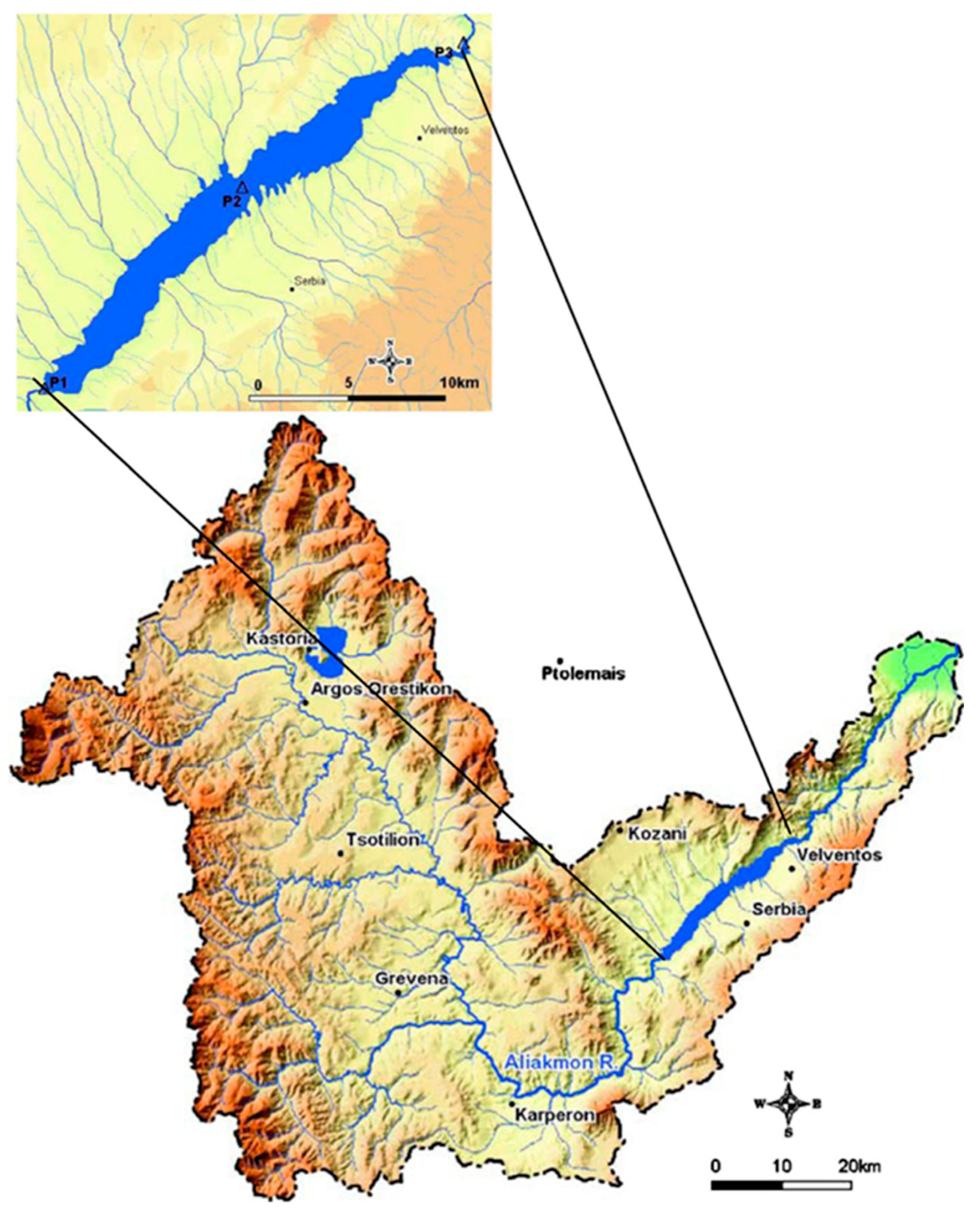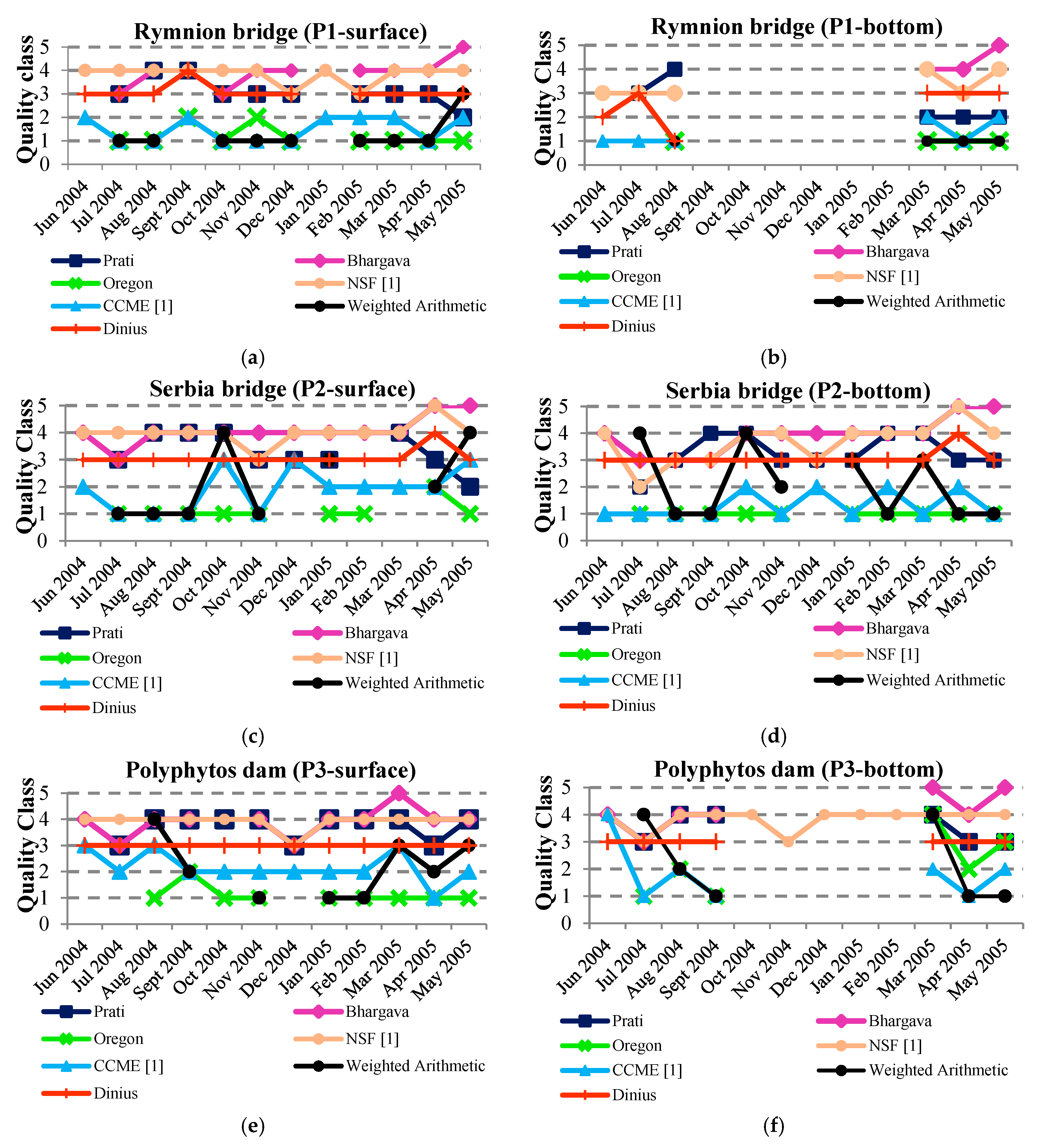Comparative Assessment of Various Water Quality Indices (WQIs) in Polyphytos Reservoir-Aliakmon River, Greece †
Abstract
:1. Introduction
2. Materials and Methods
2.1. Area of Application
2.2. Water Quality Monitoring
2.3. Application of the Methodology
3. Results and Discussion
4. Conclusions
Author Contributions
Conflicts of Interest
References
- Alexakis, D.; Tsihrintzis, V.A.; Tsakiris, G.; Gikas, G.D. Suitability of Water Quality Indices for application in lakes in the Mediterranean. Water Resour. Manag. 2016, 30, 1621–1633. [Google Scholar] [CrossRef]
- Tsakiris, G. The status of the European waters in 2015: A review. Environ. Process. 2015, 2, 543–557. [Google Scholar] [CrossRef]
- Tsakiris, V.; Alexakis, D.; Tsihrintzis, V.A. Assessing the quality of bottled water brands using a new water quality index. Eur. Water 2017, 58, 331–335. [Google Scholar]
- Abbasi, T.; Abbasi, S.A. Water Quality Indices; Elsevier: New York, NY, USA, 2012; p. 363. [Google Scholar]
- Horton, R.K. An index number system for rating water quality. J. Water Pollut. Control Fed. 1965, 37, 300–305. [Google Scholar]
- Pesce, S.F.; Wunderlin, A. Use of Water Quality Indices to verify the impact of Cordoba city (Argentina) on Suquia River. Water Res. 2000, 34, 2915–2926. [Google Scholar] [CrossRef]
- Jonnalagadda, S.B.; Mhere, G. Water quality of the Odzi River in the eastern highlands of Zimbabwe. Water Res. 2001, 35, 2371–2376. [Google Scholar] [CrossRef]
- Bordalo, A.A.; Nilsumranchit, W.; Chalermwat, K. Water quality of the Bangpakong River (Eastern Thailand). Water Res. 2001, 35, 3635–3642. [Google Scholar] [CrossRef]
- Debels, P.; Figueroa, R.; Urrutia, R.; Barra, R.; Niell, X. Evaluation of water quality in the Chillan River (Central Chile) using physicochemical parameters and a modified Water Quality Index. Environ. Monit. Assess. 2005, 110, 301–322. [Google Scholar] [CrossRef]
- Lumb, A.; Halliwell, D.; Sharma, T. Application of CCME Water Quality Index to monitor water quality: A case of the Mackenzie river basin, Canada. Environ. Monit. Assess. 2006, 113, 411–429. [Google Scholar] [CrossRef]
- Bordalo, A.A.; Teixeira, R.; Wiebe, W.J. A Water Quality Index applied to an international shared river basin: The case of the Douro River. Environ. Manag. 2006, 38, 910–920. [Google Scholar] [CrossRef]
- Sanchez, E.; Colmenarejo, M.F.; Vicente, J.; Rubio, A.; Garcia, M.G.; Travieso, L.; Borja, R. Use of the Water Quality Index and dissolved oxygen deficit as simple indicators of watersheds pollution. Ecol. Indic. 2007, 7, 315–328. [Google Scholar] [CrossRef]
- Haque, M.M.; Kader, F.; Kuruppu, U.; Rahman, A. Assessment of water quality in Hawkesbury-Nepean River in Sydney using Water Quality Index and multivariate analysis. In Proceedings of the 21st International Congress on Modelling and Simulation, Gold Coast, Australia, 29 November–4 December 2015. [Google Scholar]
- Ewaid, S.H. Water quality assessment of Al-Gharraf River, South of Iraq by Canadian Water Quality Index (CCME WQI). Iraqi J. Sci. 2016, 57, 878–885. [Google Scholar] [CrossRef]
- Moyel, M.S.; Hussain, N.A. Water quality assessment of the Shatt al-Arab River, Southern Iraq. J. Coast. Life Med. 2015, 3, 459–465. [Google Scholar] [CrossRef]
- Mitra, P.; Reddy, P.B. Application of Water Quality Index (WQI) as a tool for assessment of pollution status of Shivna River at Mandsaur, M.P. India. Trends Life Sci. J. 2016, 5. [Google Scholar] [CrossRef]
- Trikoilidou, E.; Samiotis, G.; Tsikritzis, L.; Kevrekidis, T.; Amanatidou, E. Evaluation of water quality indices adequacy in characterizing the physico-chemical water quality of lakes. Environ. Process. 2017, 4, 35–46. [Google Scholar] [CrossRef]
- Gikas, G.D. Water quantity and hydrochemical quality of Laspias River, North Greece. J. Environ. Sci. Health 2017, 52, 1312–1321. [Google Scholar] [CrossRef]
- Hashim, S.; Yuebo, X.; Hashim, I. Comparative indices evaluation to restore urban rivers water quality by using bacterial technology. Kasmera J. 2015, 43, 198–209. [Google Scholar]
- Darvishi, G.; Kootenaei, F.G.; Ramezani, M.; Lotfi, E.; Asgharnia, H. Comparative investigation of river water quality by OWQI, NSFWQI and Wilcox Indices (Case study: The Talar River-Iran). Arch. Environ. Prot. 2016, 42, 41–48. [Google Scholar] [CrossRef]
- Prati, L.; Pavanello, R.; Pesarin, F. Assessment of surface water quality by a single index of pollution. Water Res. 1971, 5, 741–751. [Google Scholar] [CrossRef]
- Bhargava, D.S. Use of water quality index for river classification and zoning of Ganga River. Environ. Pollut. 1983, 6, 51–67. [Google Scholar] [CrossRef]
- Dinius, S.H. Design of an index of water quality. JAWRA 1987, 23, 833–843. [Google Scholar] [CrossRef]
- Cude, C.G. Oregon water quality index a tool for evaluating water quality management effectiveness. JAWRA 2001, 37, 125–137. [Google Scholar] [CrossRef]
- Tyagi, S.; Sharma, B.; Singh, P.; Dobhal, R. Water quality assessment in terms of Water Quality Index. AJWR 2013, 1, 34–38. [Google Scholar] [CrossRef]
- Gikas, G.D.; Tsihrintzis, V.A.; Akratos, C.S.; Haralambidis, G. Water quality trends in Polyphytos reservoir, Aliakmon river, Greece. Environ. Monit. Assess. 2009, 149, 163–181. [Google Scholar] [CrossRef] [PubMed]
- Zotou, I. Comparative Assessment of Seven Water Quality Indices (WQIs) based on Measurements in Surface Water Systems of Greece. M.Sc. Thesis, School of Civil Engineering, National Technical University of Athens, Athens, Greece, 2017. (In Greek). [Google Scholar]
- Joint Ministerial Decision Υ2/2600/2001; Quality of water intended for human consumption in compliance with Council Directive 98/83/EC of 3 November 1998. National Printing House of Greece: Athens, Greece, 2001. (In Greek)
- 29. Joint Ministerial Decision 46399/4352/86; Quality Required for Surface Water Intended for the Abstraction of Drinking Water, Bathing, Fish Life in Freshwater and Shellfish, Methods of Measurement and Frequency of Sampling and Analysis of Surface Water Intended for the Abstraction of Drinking Water, in Compliance with Council Directives 75/440/EEC, 76/160/EEC, 78/659/EEC, 79/923/EEC and 79/869/EEC. National Printing House of Greece: Athens, Greece, 1986. (In Greek)
- World Health Organization. Guidelines for Drinking-Water Quality-Vol. 1-Recommendations, 2nd ed.; WHO: Geneva, Switzerland, 1993; p. 150. [Google Scholar]
- Canadian Council of Ministers of the Environment. Canadian water quality guidelines for the protection of aquatic life: CCME Water Quality Index 1.0, User’s Manual. In Canadian Environmental Quality Guidelines; Canadian Council of Ministers of the Environment: Winnipeg, MB, Canada, 1999. [Google Scholar]


| Variable | Prati’s Index | Bhargava’s WQI | Oregon WQI | Dinius Index | Weighted Arithmetic WQI-Recommended Standard Values |
|---|---|---|---|---|---|
| T | - | √ | √ | - | - |
| DO | √ | √ | √ | √ | √ 5 mg/L [28] |
| pH | √ | - | √ | √ | √ 6.5–9.5 [28] |
| EC | - | √ | - | √ | √ 2500 μS/cm [28] |
| Turbidity | - | √ | - | - | √ 5 NTU [30] |
| BOD5 | √ | √ | √ | √ | √ 3 mg/L [29] |
| COD | √ | - | - | - | √ 30 mg/L [29] |
| TSS | √ | - | √ | - | √ 25 mg/L [29] |
| NO2−-N | - | - | - | - | √ 3 mg/L [30] |
| NO3−-N | √ | - | √ 1 | √ | √ 50 mg/L [28] |
| NH4+-N | √ | √ | √ 1 | - | √ 0.5 mg/L [28] |
| TKN | - | - | - | - | √ 1 mg/L [29] |
| TP | - | - | √ | - | √ 0.05 mg/L [31] |
| WQI | Worst Quality Class Scenario for Each Methodology (1–5) | Quality Characterization | Position Where the Worst Scenario Was Recorded |
|---|---|---|---|
| Prati’s Index of Pollution | 2 | Pollution | Ρ1 (bottom) |
| Bhargava’s Index | 3 | Satisfactory water quality | Ρ2 (bottom) |
| Oregon WQI | 1 | Very poor water quality | Ρ1 (surface) |
| NSF WQI [1] | 2 | Bad water quality | Ρ2 (surface) |
| CCME WQI [1] | 1 | Poor water quality | Ρ1 (surface) |
| Weighted Arithmetic WQI | 1 | Unacceptable for drinking purposes | Ρ2 (surface) |
| Dinius Index | 1 | Unacceptable water quality | Ρ1 (bottom) |
Publisher’s Note: MDPI stays neutral with regard to jurisdictional claims in published maps and institutional affiliations. |
© 2018 by the authors. Licensee MDPI, Basel, Switzerland. This article is an open access article distributed under the terms and conditions of the Creative Commons Attribution (CC BY) license (https://creativecommons.org/licenses/by/4.0/).
Share and Cite
Zotou, I.; Tsihrintzis, V.A.; Gikas, G.D. Comparative Assessment of Various Water Quality Indices (WQIs) in Polyphytos Reservoir-Aliakmon River, Greece. Proceedings 2018, 2, 611. https://doi.org/10.3390/proceedings2110611
Zotou I, Tsihrintzis VA, Gikas GD. Comparative Assessment of Various Water Quality Indices (WQIs) in Polyphytos Reservoir-Aliakmon River, Greece. Proceedings. 2018; 2(11):611. https://doi.org/10.3390/proceedings2110611
Chicago/Turabian StyleZotou, Ioanna, Vassilios A. Tsihrintzis, and Georgios D. Gikas. 2018. "Comparative Assessment of Various Water Quality Indices (WQIs) in Polyphytos Reservoir-Aliakmon River, Greece" Proceedings 2, no. 11: 611. https://doi.org/10.3390/proceedings2110611
APA StyleZotou, I., Tsihrintzis, V. A., & Gikas, G. D. (2018). Comparative Assessment of Various Water Quality Indices (WQIs) in Polyphytos Reservoir-Aliakmon River, Greece. Proceedings, 2(11), 611. https://doi.org/10.3390/proceedings2110611




